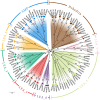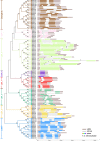Genome-wide identification, structural analysis and new insights into late embryogenesis abundant (LEA) gene family formation pattern in Brassica napus
- PMID: 27072743
- PMCID: PMC4829847
- DOI: 10.1038/srep24265
Genome-wide identification, structural analysis and new insights into late embryogenesis abundant (LEA) gene family formation pattern in Brassica napus
Abstract
Late embryogenesis abundant (LEA) proteins are a diverse and large group of polypeptides that play important roles in desiccation and freezing tolerance in plants. The LEA family has been systematically characterized in some plants but not Brassica napus. In this study, 108 BnLEA genes were identified in the B. napus genome and classified into eight families based on their conserved domains. Protein sequence alignments revealed an abundance of alanine, lysine and glutamic acid residues in BnLEA proteins. The BnLEA gene structure has few introns (<3), and they are distributed unevenly across all 19 chromosomes in B. napus, occurring as gene clusters in chromosomes A9, C2, C4 and C5. More than two-thirds of the BnLEA genes are associated with segmental duplication. Synteny analysis revealed that most LEA genes are conserved, although gene losses or gains were also identified. These results suggest that segmental duplication and whole-genome duplication played a major role in the expansion of the BnLEA gene family. Expression profiles analysis indicated that expression of most BnLEAs was increased in leaves and late stage seeds. This study presents a comprehensive overview of the LEA gene family in B. napus and provides new insights into the formation of this family.
Figures







Similar articles
-
Genome-wide mining and comparative analysis of fatty acid elongase gene family in Brassica napus and its progenitors.Gene. 2020 Jul 15;747:144674. doi: 10.1016/j.gene.2020.144674. Epub 2020 Apr 15. Gene. 2020. PMID: 32304781
-
Genome-wide identification and characterization of late embryogenesis abundant protein-encoding gene family in wheat: Evolution and expression profiles during development and stress.Gene. 2020 Apr 30;736:144422. doi: 10.1016/j.gene.2020.144422. Epub 2020 Jan 31. Gene. 2020. PMID: 32007584
-
Genome-wide identification, functional prediction, and evolutionary analysis of the R2R3-MYB superfamily in Brassica napus.Genome. 2017 Oct;60(10):797-814. doi: 10.1139/gen-2017-0059. Epub 2017 Jul 21. Genome. 2017. PMID: 28732175
-
Molecular identification of the magnesium transport gene family in Brassica napus.Plant Physiol Biochem. 2019 Mar;136:204-214. doi: 10.1016/j.plaphy.2019.01.017. Epub 2019 Jan 17. Plant Physiol Biochem. 2019. PMID: 30690277 Review.
-
The continuing conundrum of the LEA proteins.Naturwissenschaften. 2007 Oct;94(10):791-812. doi: 10.1007/s00114-007-0254-y. Epub 2007 May 4. Naturwissenschaften. 2007. PMID: 17479232 Review.
Cited by
-
Genome-Wide Identification and Expression Analysis of the Zinc Finger Protein Gene Subfamilies under Drought Stress in Triticum aestivum.Plants (Basel). 2022 Sep 26;11(19):2511. doi: 10.3390/plants11192511. Plants (Basel). 2022. PMID: 36235376 Free PMC article.
-
Genome-wide analysis of Triticum aestivum bromodomain gene family and expression analysis under salt stress.Planta. 2024 Oct 15;260(5):117. doi: 10.1007/s00425-024-04549-1. Planta. 2024. PMID: 39404907
-
Investigating the In Vitro Regeneration Potential of Commercial Cultivars of Brassica.Plants (Basel). 2019 Nov 29;8(12):558. doi: 10.3390/plants8120558. Plants (Basel). 2019. PMID: 31795525 Free PMC article.
-
Genome-wide identification, phylogeny, evolutionary expansion and expression analyses of bZIP transcription factor family in tartaty buckwheat.BMC Genomics. 2019 Jun 11;20(1):483. doi: 10.1186/s12864-019-5882-z. BMC Genomics. 2019. PMID: 31185893 Free PMC article.
-
Genome-wide characterization of LEA gene family reveals a positive role of BnaA.LEA6.a in freezing tolerance in rapeseed (Brassica napus L.).BMC Plant Biol. 2024 May 21;24(1):433. doi: 10.1186/s12870-024-05111-7. BMC Plant Biol. 2024. PMID: 38773359 Free PMC article.
References
-
- Taji T. et al. Important roles of drought-and cold-inducible genes for galactinol synthase in stress tolerance in Arabidopsis thaliana. The Plant Journal 29, 417–426 (2002). - PubMed
-
- Dure L. III et al. Common amino acid sequence domains among the LEA proteins of higher plants. Plant Molecular Biology 12, 475–486 (1989). - PubMed
Publication types
MeSH terms
LinkOut - more resources
Full Text Sources
Other Literature Sources
Molecular Biology Databases
Miscellaneous

